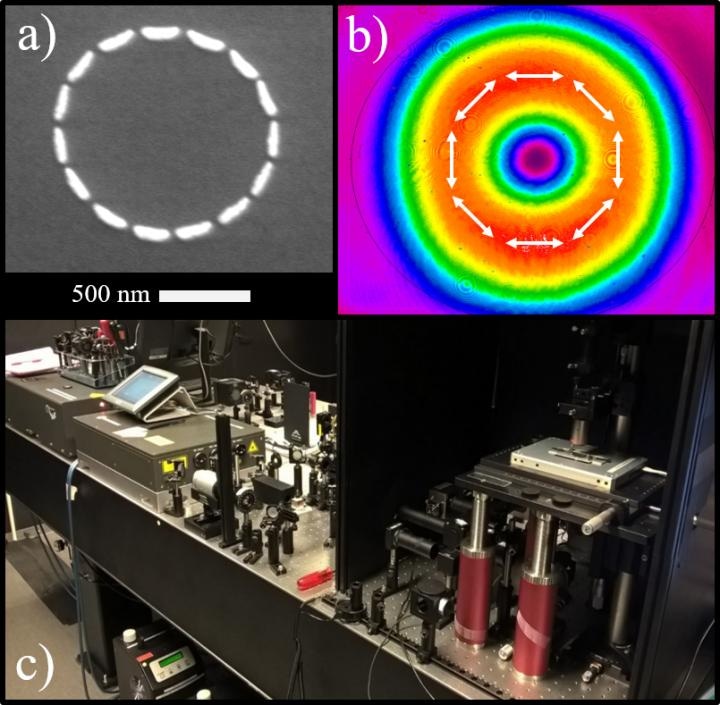Apr 24 2018
What is the result of exciting innovative assemblies of nanomaterials with the help of structured light? A collaborative study between Tampere University of Technology (TUT) (Finland) and University of Tübingen (Germany) has demonstrated that cautiously structured light and matching arrangements of metal nanostructures, or “plasmonic oligomers,” can be blended to change the properties of the generated light at the nanoscale.
 (a) Plasmonic gold oligomer consisting of nanorods that are azimuthally arranged. The oligomers were fabricated at the University of Tübingen. (b) The intensity profile of the azimuthally polarized cylindrical vector beam used in the experiments. (c) Nonlinear optical microscope equipped with cylindrical vector beams at the Nonlinear Optics Group, Laboratory of Photonics at TUT. (Image credit: Laboratory of Photonics at TUT)
(a) Plasmonic gold oligomer consisting of nanorods that are azimuthally arranged. The oligomers were fabricated at the University of Tübingen. (b) The intensity profile of the azimuthally polarized cylindrical vector beam used in the experiments. (c) Nonlinear optical microscope equipped with cylindrical vector beams at the Nonlinear Optics Group, Laboratory of Photonics at TUT. (Image credit: Laboratory of Photonics at TUT)
Specifically, the research groups have demonstrated that the efficiency of nonlinear optical fields - for instance, second-harmonics - produced from the oligomers is strongly impacted by the arrangement of the constituents of the oligomer in space and the way these constituents are illuminated by structured light.
Nonlinear optical processes provide are crucial for significant functionalities in photonics, for instance, generation of ultrashort light pulses, frequency conversion of light, and also optical processing and manipulation. Further progress in this field is anticipated to be induced by the production of innovative nanomaterials that have customizable optical characteristics and by innovative strategies for efficiently coupling light into these nanomaterials. For achieving the coupling of light, light beams with non-traditional polarizations, or structured light, are anticipated to be vital.
For establishing such potentials, the researchers designed and created assemblies of gold nanorods that had well-marked dimensions and orientations such that their comprehensive size is in accordance with the size of a focused laser beam, that is, around 1 μm. The researchers adopted an innovative optical microscopy method, equipped with polarization-structured beams, for analyzing the nonlinear response of the plasmonic oligomers. In particular, the researchers employed azimuthally and radially polarized cylindrical vector beams that exhibit non-uniform states-of-polarization across the cross-section of the beam.
Previous works on nonlinear optical effects in plasmonic oligomers have been based on using plane waves or focused beams with homogenous, i.e., uniform, states of polarizations. Here, we used a nonlinear optical microscope equipped with doughnut-shaped polarization-structured beams to study such oligomers. We found that the overall efficiency of nonlinear optical effects from these structures is strongly affected by the spatial structure of the beam and collective interactions supported by the oligomer. We hope that our work will further spark interest in studying and manipulating nonlinear optical effects in novel nanoscale systems using unconventional excitation beams.
Dr Godofredo Bautista, Co-Corresponding Author & Postdoctoral Researcher - Nonlinear Optics Group of the Laboratory of Photonics at TUT
Beyond the nonlinear effects studied in the present work, our results show in general how important it is to tailor the incident optical beam in order to couple light efficiently into complex nanostructures.
Professor Martti Kauranen, Supervisor of the Study & Head of the Nonlinear Optics Group & Laboratory of Photonics
In the words of Professor Monika Fleischer, co-corresponding author of the study and head of the Plasmonic Nanostructures Group at the University of Tübingen, who supervised the study at the University of Tübingen, “Nanotechnology provides high-precision tools that allow us to tailor arrangements of metallic nanostructures, also called optical antennas, with pre-designed properties. This way specific interactions with non-conventional laser beams can be targeted, and overall signal intensities may be maximized.”
The authors are hopeful that their outcomes will be beneficial in designing and implementing innovative types of optical components and characterization methods that employ non-traditional optical fields.
This study was funded by The Academy of Finland (267847 and 287651), TUT Investment funding for Optics and Photonics and COST Action MP1302 Nanospectroscopy.